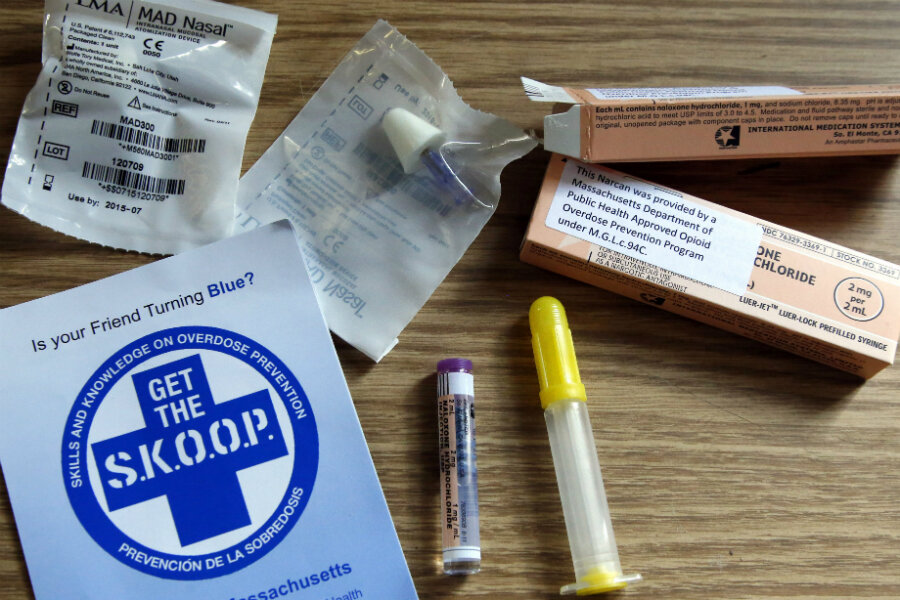Drug overdose deaths climb dramatically across US, again. Solutions?
Loading...
| Boston
Rick Sotiropoulos was a freshman baseball player for Merrimack College in North Andover, Mass., when he underwent surgery for an injured elbow. The procedure was successful. But the recovery introduced him to opiates.
Like many Americans who find themselves hooked on prescription painkillers, Mr. Sotiropoulos began legally, with Oxycodone, as he recovered from the operation. At first he resisted the numbing high, ridding himself of his last prescription when he saw he had a problem. But within five years, he was using pills almost daily – then came heroin.
Sotiropoulos got help. He's been clean a full year, as of last Sunday, despite the ups and downs of prior relapse: "I've made almost every mistake in recovery that there is, and I'm blessed to still be here," he tells The Christian Science Monitor.
Over the past five years, the United States has seen a dramatic rise in drug overdose deaths, driven largely by heroin and synthetic opioids other than methadone, according to a US Centers for Disease Control and Prevention report released last week. In 2010, overdoses killed 38,329 people. That figure jumped 23 percent to 47,055 in 2014. Last year, the figure jumped again to 52,404 – numbers that have sent health and law enforcement officials scrambling for solutions.
Those statistics are not mere numbers for Sotiropoulos. He's lost friends to the epidemic: six from the halfway house in East Boston where he's completed two stints, and two from his hometown in Ipswich.
Sotiropoulos says his recovery has been hard work but worthwhile. He's had to uproot, physically relocate, to avoid certain social circles, steer clear of certain places, and keep connected with a support system that includes 12-step meetings and a sponsor to hold him accountable. Every single decision must point him toward that goal of keeping clean and sober, he says.
"I don’t think I’ve arrived in any way. I’ve made that mistake before," Sotiropoulos tells the Monitor in a phone interview. "I know my recovery is an ongoing day-to-day process. I mean, I can look back and feel good about what I’ve accomplished in a year and look forward to what I can accomplish in the future by staying clean.
"But if I look too far ahead, then that’s where I could make a mistake and fall back. I just have to keep things simple, keep working the program and just worry about one day at a time."
Gayle Saks, a substance abuse counselor who advised Sotiropoulos at an all-male halfway house, says his story is a prime example of the difficult road to recovery.
"The real success stories are the guys who are working the program, who are going to meetings, who are working with sponsors, and those are the ones who are staying clean," Ms. Saks tells the Monitor in a phone interview.
Massachusetts ranks among the top four states for the recent rise in heroin overdose deaths, alongside Connecticut, Ohio, and West Virginia, as HealthDay reported. The crisis here, for Saks, is tangible.
"I have pictures from a year ago, from our last Christmas party. A picture of each guy. I have them on my phone," she says. "Three-quarters of them are either dead or out running the streets."
"I can’t even begin to tell you how horrible it is," she adds.
In response to the epidemic, US physicians began reducing prescriptions for opioid drugs. For the first time in two decades, opioid prescriptions have fallen during the past three years, and law enforcement leaders have collaborated with health professionals to meet the massive need for treatment. The CDC recommends systemic solutions that include improving access to prescription drug monitoring programs and enhancing distribution of naloxone, a drug that counteracts the effect of a heroin overdose. The crisis has elicited responses from federal, state, and local authorities alike, from major coastal cities to small Midwestern towns.
Massachusetts Gov. Charlie Baker, since taking office last year, has sought to improve treatment quality and availability, limit opioid prescriptions, and increase the use of overdose counteracting drugs, as The Boston Globe's Evan Horowitz reported earlier this year.
But there is work to be done interpersonally as well, Saks says, suggesting that people need to listen to those caught up in drugs, refrain from passing judgment, and encourage them to embrace whatever treatment program works.
"Absent a single solution, the multipronged approach seems to make the most sense, including a combination of heightened anti-trafficking efforts, better treatment, and ongoing public education," Mr. Horowitz wrote, suggesting that inter-state collaboration may be in order.
"And given that opioids have become a marked problem for our region as a whole, state policy alone may not suffice," he added. "This Massachusetts crisis may require a New England solution."








